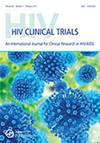Quality of life improvement in HIV-1 patients treated with raltegravir in a real-life observational study: RACING
Q2 Medicine
引用次数: 6
Abstract
Background: Good efficacy and safety of raltegravir in person living with HIV was demonstrated in clinical trials over five years, but real-life data, particularly about quality of life (QoL), are lacking. QoL was evaluated over time in adult patients first treated or switched to regimens containing raltegravir in an observational cohort study. Methods: Patient QoL was evaluated using the Fatigue Impact Scale (FIS) and the HIV Symptom Index (HSI). Data were collected at baseline and at 1, 3, 6, 12, 18, and 24 months. Baseline FIS and HSI subscores were compared with the scores at each visit using the paired Wilcoxon test. The impact of time, sociodemographic and medical variables upon patient-perceived fatigue and symptoms was also assessed using mixed multivariate models. Results: From baseline, all FIS and HSI subscores improved significantly after one month of treatment. In addition, psychosocial FIS subscores and both the frequency of bothersome symptoms and HSI subscores improved significantly at each visit. Physical FIS subscores also improved significantly, except at month 18, whereas both cognitive and total FIS subscores improved only after 6 months and 24 months, respectively. In multivariate analysis, employment was independently associated over time with improved improvement in both FIS and HSI subscores. Conclusion: Patient QoL improved significantly over a 24-month period of treatment with a raltegravir-containing regimen. FIS and HSI are sensitive tools to measure the impact of new antiretroviral combinations on a patient’s perception of QoL.在一项现实生活观察性研究:race中,接受雷替重力韦治疗的HIV-1患者的生活质量改善
背景:在过去5年的临床试验中证明了雷替格拉韦对HIV感染者的良好疗效和安全性,但缺乏实际数据,特别是关于生活质量(QoL)的数据。在一项观察性队列研究中,对首次治疗或改用含有雷替韦韦方案的成年患者的生活质量进行了评估。方法:采用疲劳影响量表(FIS)和HIV症状指数(HSI)对患者的生活质量进行评价。在基线和1、3、6、12、18和24个月时收集数据。使用配对Wilcoxon检验将基线FIS和HSI评分与每次就诊时的评分进行比较。时间、社会人口和医学变量对患者感知的疲劳和症状的影响也使用混合多变量模型进行了评估。结果:从基线开始,治疗一个月后,所有FIS和HSI评分均显著改善。此外,每次就诊时,心理社会FIS评分、恼人症状的频率和HSI评分均有显著改善。除了第18个月外,身体FIS评分也有显著改善,而认知和总FIS评分分别在6个月和24个月后才有所改善。在多变量分析中,随着时间的推移,就业与FIS和HSI分值的改善独立相关。结论:经含替地韦治疗24个月后,患者的生活质量明显改善。FIS和HSI是衡量新的抗逆转录病毒组合对患者生活质量感知影响的敏感工具。
本文章由计算机程序翻译,如有差异,请以英文原文为准。
求助全文
约1分钟内获得全文
求助全文
来源期刊

HIV Clinical Trials
医学-传染病学
CiteScore
1.76
自引率
0.00%
发文量
0
审稿时长
>12 weeks
期刊介绍:
HIV Clinical Trials is devoted exclusively to presenting information on the latest developments in HIV/AIDS clinical research. This journal enables readers to obtain the most up-to-date, innovative research from around the world.
 求助内容:
求助内容: 应助结果提醒方式:
应助结果提醒方式:


